I have always been fascinated by the “jardin d’hiver” or winter garden of the Hôtel de la Païva. It is my dream garden, and I have promised myself that one day when I am able to buy a house, I will look for a similar space or try to recreate it if it doesn’t exist. So if you also love this magical space, then in today’s post, I will provide a few tips on how you can create this enchanting winter garden in your home.
All the photos featured in this post were captured by the photographer Raphael Metivet.
About the Hôtel de la Païva
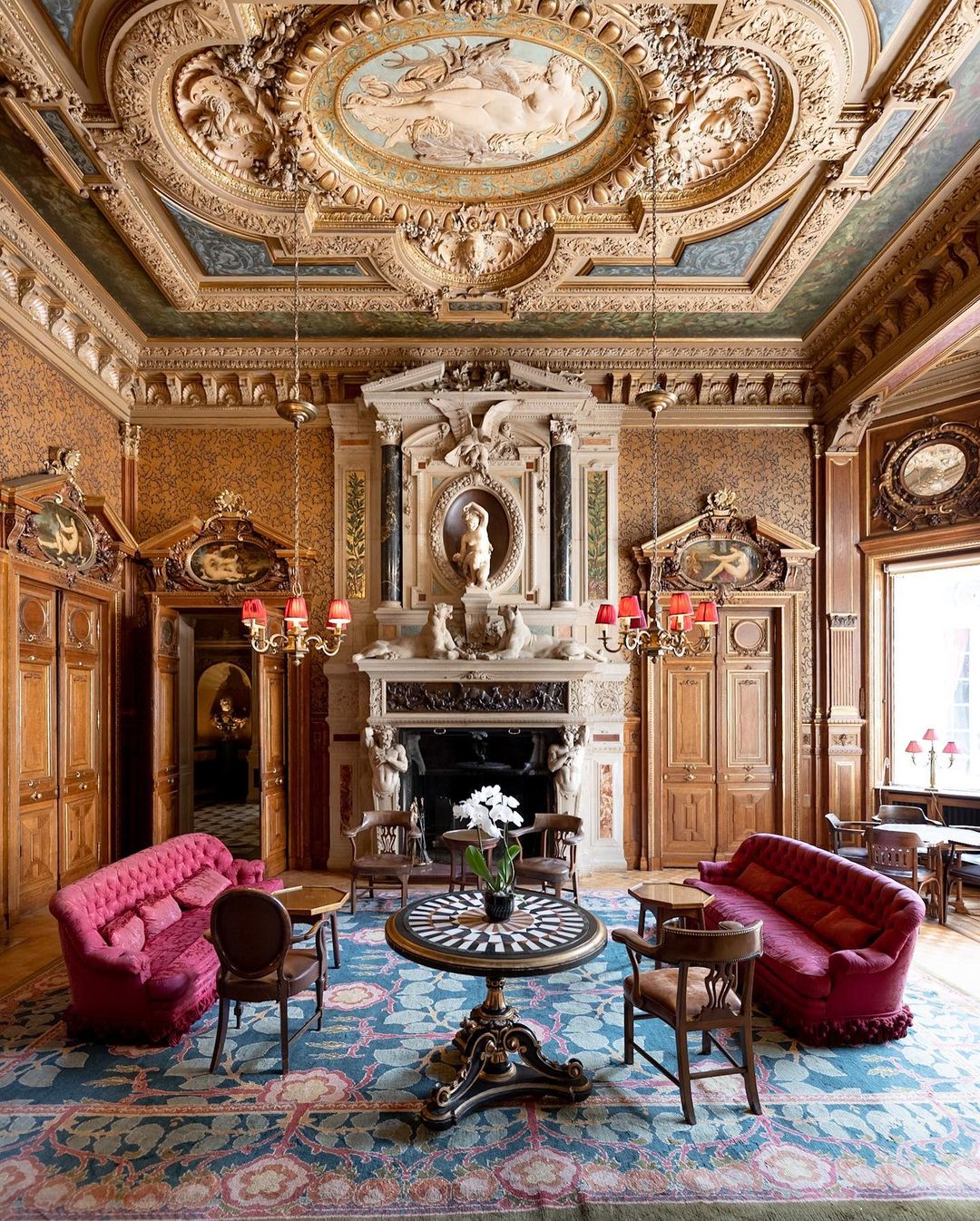
The Hôtel de la Païva was constructed between 1856 and 1866 at number 25 on the famous Avenue des Champs-Elysées by the courtesan Esther Lachmann, also known as La Païva. Born into a modest family in Moscow, Russia, Esther became a Portuguese marchioness and a Prussian countess by successive marriages. Her last marriage to Count Henckel von Donnersmarck provided her with the funds to build the hotel. The construction lasted for ten years and cost 10 million gold francs, which is worth about 40 million euros today.
La Païva commissioned Pierre Manguin to build the hotel in the Italian Renaissance style. It was designed to showcase the work of the best artists and craftsmen of the time. Paintings by Paul Baudry, who was in charge of the foyer of the Garnier Opera, are displayed alongside sculptures by Jules Dalou and Albert Ernest Carrier-Belleuse, ceramics by Théodore Deck, and superb fireplaces by Barbedienne.
The hotel’s two most remarkable features are a staircase made of onyx marble from Algeria, which was particularly noteworthy during the Universal Exhibition of 1867 and a Neo-Mauresque style bathroom. The bathroom is notable for its white onyx bathtub and silver bronze tub, which the marquise would have bathed in champagne, milk, or linden. The large living room offers a view of the Champs-Élysées, and the bedroom has an oriental ceiling. At the back, the winter garden is one of the sweetest details of the hotel, a breath of fresh air amidst the visual overload.
Since 1903, the hotel has been used by the Travellers Club of Paris and can be visited during European Heritage Days and via private tours organized by Martine Peyrat or Des Mots et des Arts.
The “Jardin d’Hiver” or Winter Garden
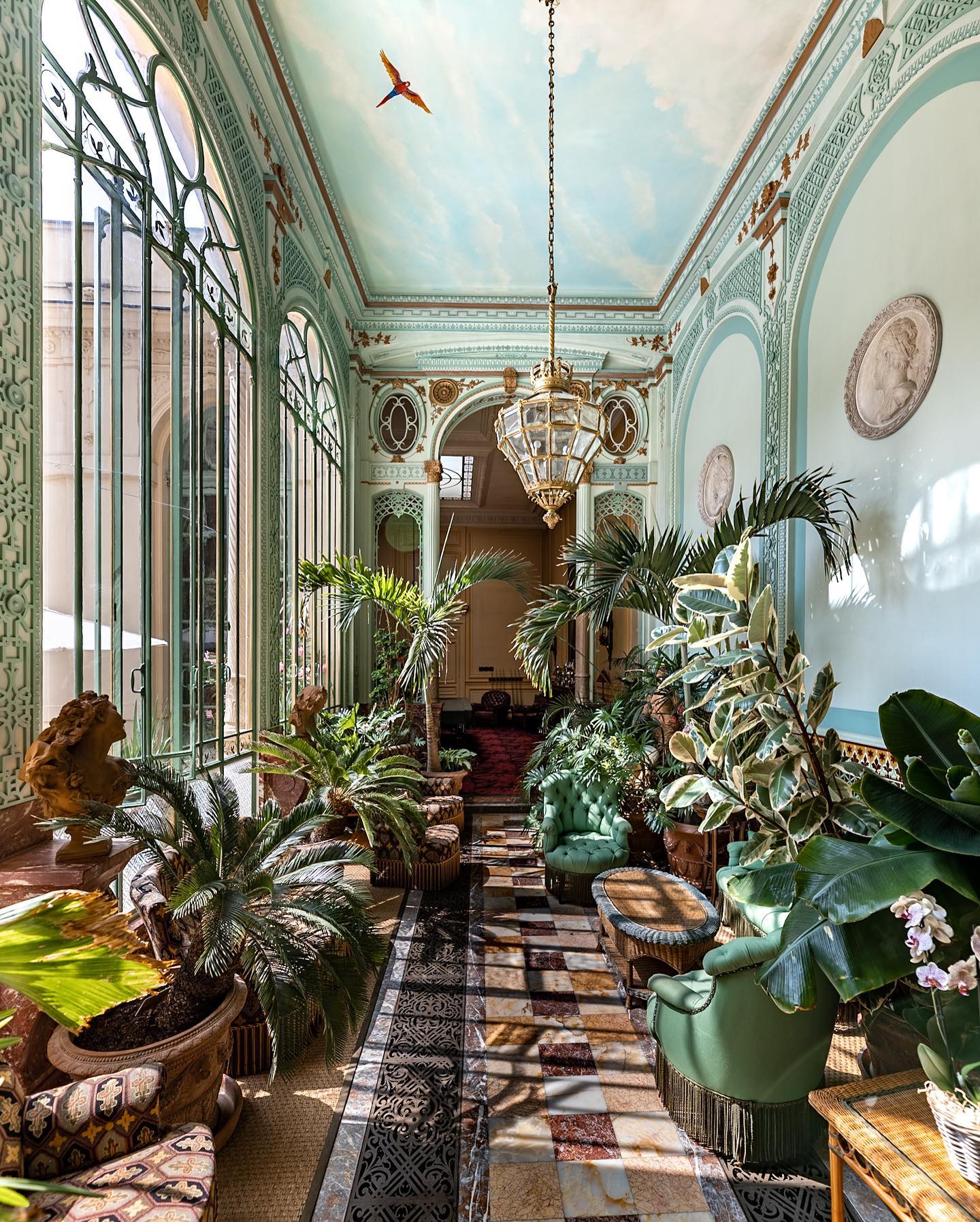
Winter gardens, which originated from orangeries in the 16th century, became popular in the 19th century with the emergence of industrial metal architecture and Art Nouveau glasshouses. From the 1860s-1870s, conservatory salons, balcony greenhouses, and bow-windows became widespread in Paris. This allowed people to create their own winter gardens at home, inspired by the numerous winter gardens that were being built in the city. Some of the most notable ones were the Champs-Élysées Winter Garden (1847), the Winter Palace of the Jardin d’Acclimatation (1861), the new greenhouses of the Jardin des Plantes (1880), and the greenhouses constructed for the Universal Expositions of 1867, 1878, 1889, and 1900.
These heated leisure rooms, which faced the garden or park, were used to host collections of exotic plants and indoor palms grown in movable pots, as well as for tea or more intimate receptions. Nowadays, the term “winter garden” refers to any space that features vegetation, whether it is a conservatory, a large greenhouse, or a patio. The contemporary interpretation of a winter garden places a strong emphasis on creating a tranquil oasis within the home, especially in spaces bathed in natural light from large windows, bay windows, or bow windows. Let’s explore how to create a stunning winter garden in your home inspired by the design of the Hôtel de la Païva.
Recreate This Winter Garden in Your Home
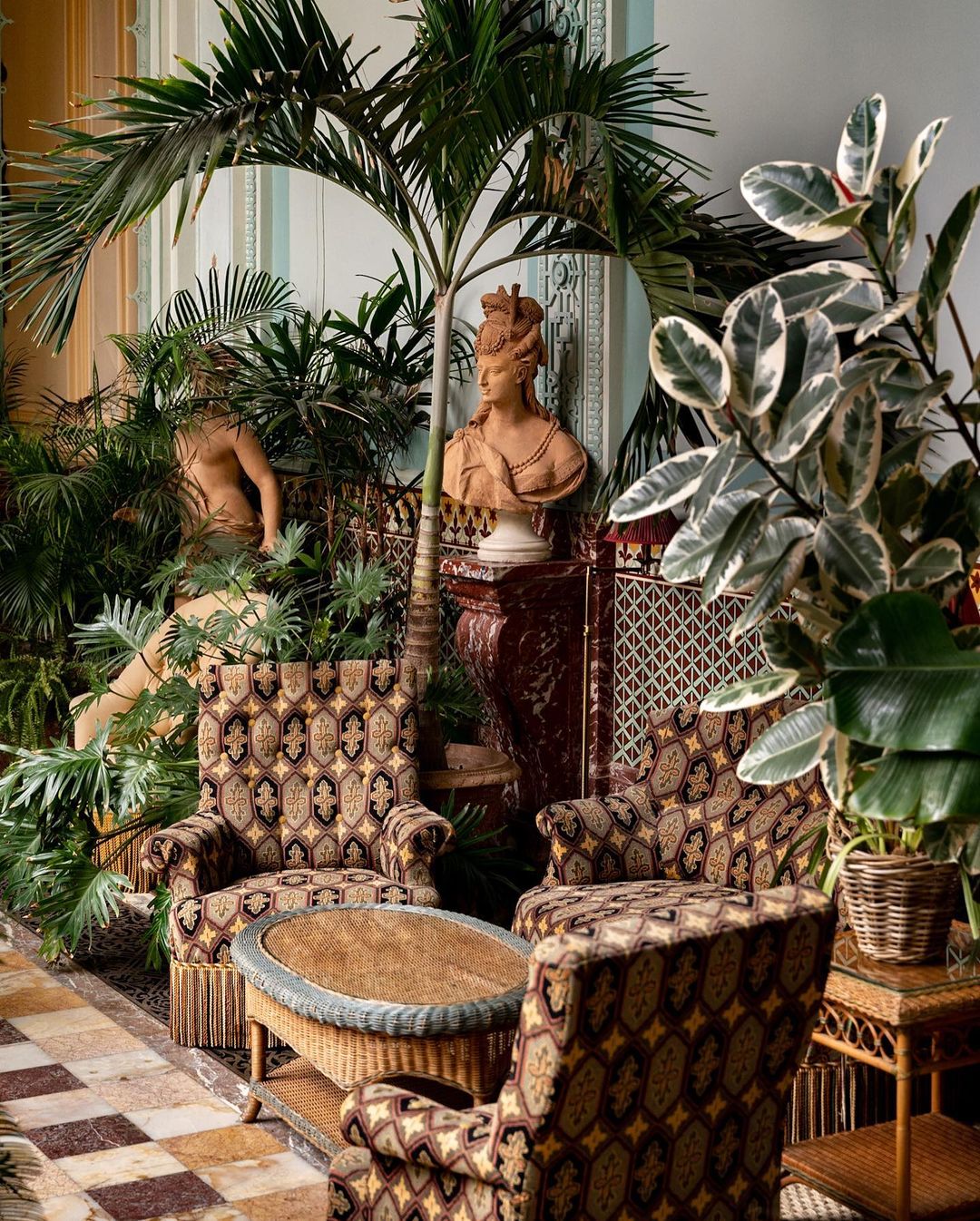
1. Walls & Ceiling
For the walls, I would recommend choosing different shades of grayish teal—a balanced blend of green and blue, softened by a gray undertone—or pale aqua. To add a touch of earthiness, you can use a shade of brown resembling bronze or dusty copper for the molding details. You can add moldings to the wall and ceiling to complete the look. Antique cameo wall art would be a great addition to the walls, too.
Alternatively, you can opt for a tropical or exotic panoramic wallpaper on the side of the wall opposite the large windows. This creates the illusion of a lush jungle animated by exotic birds and animals. You can choose from a variety of wallpapers, but my favorite is this gorgeous Palm Grove wallpaper by Papiers de Paris or this beautiful Brazil 1862 wallpaper, which is a panoramic view of Brazilian decor with exotic birds, palms, and trees.
For the ceiling, I adore the representation of the sky painted here. The flying parrot detail is amazing! Opt for a light shade of cyan or a soft sky blue, which evokes the calmness and clarity of a serene sky. This refreshing and peaceful hue is often used in design and decor to create a light, airy, and tranquil atmosphere, ideal for spaces intended for relaxation or contemplation like a “jardin d’hiver”.
This post is not sponsored, and all opinions are my own. I only feature products I truly love and personally select. If you purchase through my links, I may earn a small commission at no extra cost to you. Merci!
2. Rattan & Velvet Furniture

To create an enchanting winter garden, I suggest using a mix of rattan and velvet furniture in jewel tones like emerald, lapis, amethyst, midnight, or golden. Here are some furniture pieces that I recommend for this purpose:
- A pair of French Napoleon III button-tufted velvet armchairs in jewel tones can be easily found in antique stores. Alternatively, you can opt for this Anthropologie Cosette Swivel chair or Velvet Stasia stool.
- A Moroccan-inspired coffee table like this beautiful Moroccan Inlay Waterfall coffee table for an exotic touch.
- A few rattan chairs like the original Parisian bistro chairs from Maison Louis Drucker. Alternatively, you could consider this gorgeous Peacock Rattan Dining chair and Tulip Indoor/Outdoor chair.
- Vintage pots and planters like this Oakhurt Concrete urn, Ribbed Terracotta taper pot, and Barnacle French urn.
- If you have some space, you can add a buffet like this or a .
- You can also add busts to enhance the overall ambiance of the winter garden. I recommend these beautiful or or this Grecian bust pot.
3. Tropical and Exotic Plants
I love plants, especially exotic and tropical ones. Here are a few plants that I have identified in the photo, plus some of my favorites:
- Sago palm (Cycas revoluta)
- Bird of Paradise (Strelitzia Nicolai or Strelitzia Reginae)
- Rubber plant (Ficus Elastica)
- Banana plant (Musa Dwarf)
- Coconut palm (Cocos Nucifera)
- Ruffled fan palm (Licuala Grandis)
- Areca palm (Dypsis Lutescens)
- Orchid
- Tasmanian tree fern (Dicksonia Antarctica)
Et voilà! You can now transform your home into a Parisian paradise and recreate the iconic winter garden of the Hôtel de la Païva. Let me know if you have any questions in the comments below. Merci!
Bonjour! I’m Léonce, the founder of Léonce Chenal, a blog dedicated to French fashion, beauty, and lifestyle. I’m French and launched Léonce Chenal in 2018 while working as a data analyst in London, inspired to share my love of effortless French style. After living in Paris, London, and Amsterdam, I’ve now settled in the beautiful city of Bordeaux. When I’m not writing, you’ll find me baking pâtisseries, exploring hidden museums, or on the hunt for the perfect perfume.

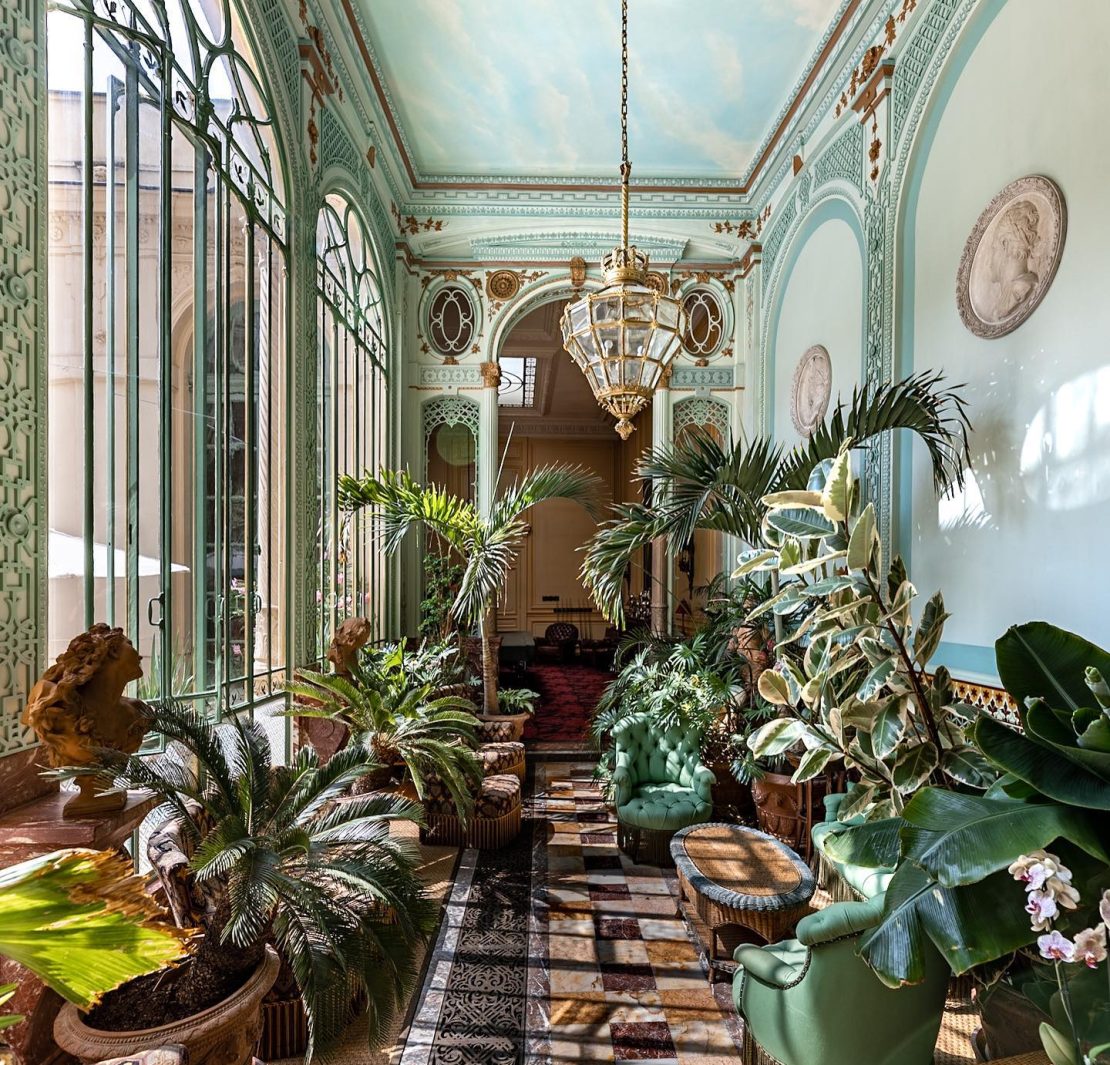
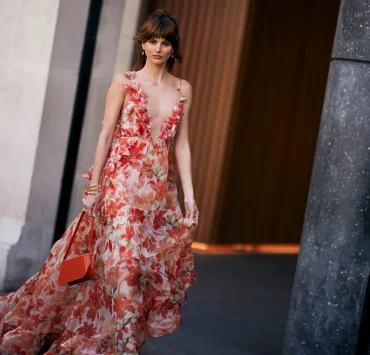

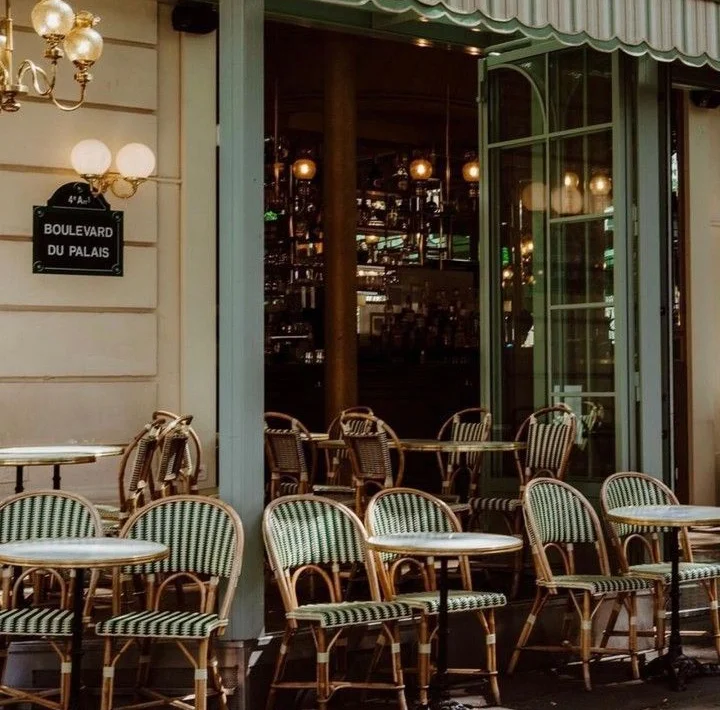
Stunning! I love all indoor plant rooms. I’m British, living in the San Francisco Bay Area, and we have a north east facing sunroom, so two walls of windows. We decorated more in the British Colonial style, but there are overlaps, particularly the rattan furniture and all the greens (green cushions on the seating). Walls are a natural linen colour with white trim/casework. And then plants, plants, plants – hanging ferns, fiddle leaf fig trees, umbrella plants, big palms, snake plants etc. Coffee table books. Blue and white plant pots. My nanas prized Royal Doulton china set. Interesting bits and pieces, including African art that I inherited from my parents, who between then spent time in Kenya and Zambia in the 1960’s and 70’s. It’s probably my favourite room in the house!
Love seeing these beautiful and iconic spaces in Paris. The architecture and design of your city is absolutely gorgeous.
Bonjour Lindsey, thank you so much for your lovely comment! Your jardin d’hiver sounds absolutely stunning! It’s wonderful to connect over our shared love for beautiful, plant-filled spaces 🙂 If you love blue and white china sets, I recommend checking out Royal Delft —I absolutely love their vases and plates. Thank you again for sharing your story and for your kind words! xo